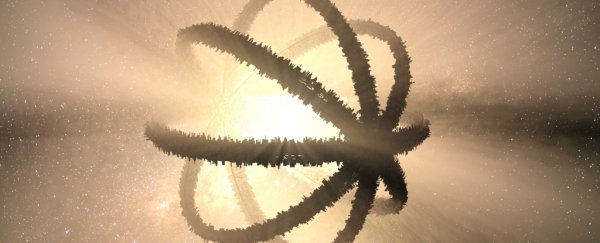One of the biggest questions we have about the Universe is: Are we alone as a technologically advanced species? This raises other questions: If aliens are out there, what would their technology look like? And, pertinently, how could we detect it?
A new study has laid out some answers to these questions – at least, if the technology in question is a type of insane energy harvester called a Dyson sphere, drawing down energy from a black hole.
"In this study, we consider an energy source of a well-developed Type II or a Type III civilization. They need a more powerful energy source than their own Sun," the researchers write in their paper.
"An accretion disk, a corona, and relativistic jets could be potential power stations for a Type II civilization. Our results suggest that for a stellar-mass black hole, even at a low Eddington ratio, the accretion disk could provide hundreds of times more luminosity than a main sequence star."
The concept of a Dyson sphere was popularized by theoretical physicist Freeman Dyson in the 1960s as a solution to the problem of power consumption that exceeds the capabilities of a civilization's planet. The sphere itself is built around the planetary system's star – a megastructure that harvests the star's energy at the source.
Dyson's paper proposed that infrared emissions of thermal energy might escape as the Dyson structure captures and converts stellar energy, which could hypothetically give away the presence of these hypothetical structures. This infrared signature, if we could detect it, would allow us to home in on alien civilizations.
Led by astronomer Tiger Yu-Yang Hsiao of National Tsing Hua University in Taiwan, a team of researchers has taken the concept a step further. What if the Dyson sphere (or Dyson ring or Dyson swarm) was arranged around a black hole? Would it work, and what would we be able to detect, from here on Earth?
The one thing above all others that black holes are known for is their powerful gravitational field that slurps up everything that draws close enough, and doesn't let it out again (that we can detect).
You might, therefore, be wondering how one could harvest anything from such a beast. As it turns out, there are a number of processes in the extreme environment around a black hole from which energy could possibly be harvested.
In their paper, the team consider a number of these processes: the accretion disk of material swirling around a black hole, super-heated by friction to up to millions of degrees; Hawking radiation, the theoretical black-body radiation emitted by black holes proposed by Stephen Hawking.
Other potentially relevant phenomena that could contribute include spherical accretion, the corona of magnetized plasma between the inner edge of the accretion disk and the event horizon, and the jets launched at relativistic speeds from the poles of active black holes.
Based on models of black holes clocking in at 5, 20, and 4 million times the mass of the Sun (which is the mass of Sagittarius A*, the supermassive black hole at the heart of the Milky Way), Hsiao and colleagues were able to determine that a sphere of satellites would be able to effectively harvest energy from some of these processes.
"The largest luminosity can be collected from an accretion disk, reaching 100,000 times the luminosity of the Sun, enough to maintain a Type II civilization," the researchers write.
"Moreover, if a Dyson sphere collects not only the electromagnetic radiation but also other types of energy (e.g., kinetic energy) from the jets, the total collected energy would be approximately five times larger."
Such structures would be detectable across multiple wavelengths, the researchers found, with hotter Dyson spheres more visible across the ultraviolet range, and cooler Dyson spheres visible in infrared, just as Dyson himself predicted.
However, given that active black holes already emit a lot of radiation in both these wavelength ranges, making a detection of the Dyson excess could be easier said than done.
The team suggests that making other measurements, such as changes in light as the black hole is minutely affected by the gravity of the sphere, could help reveal where these structures might be hiding.
The research has been published in the Monthly Notices of the Royal Astronomical Society.
